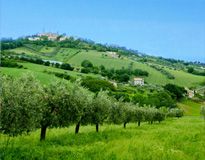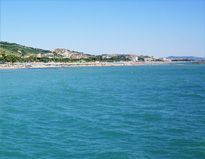
Around the IX there was a notable development of the Benedictine cult in the valleys Teramo, of Tordino, of Mavone and particularly in the valley of Vomano river where the Benedictine monks, with the help of the local populations, built important cloister.
They are stone giant that lead up to San Gabriele dell’Addolorata Sanctuary, to the feet of Gran Sasso in Teramo province, Sanctuary among the most known in Italy and in Europe (a recent classification puts it among the first fifteen Sanctuaries more frequented of the world).
San Clemente al Vomano (Notaresco)
It was built in the second half of IX century and surely not over the 890.
The legend on the origins hands tolds of a standstill (historically confirmed not) of emperor Ludovico II's family in the "castle" of Guardia Vomano, happened during the escape from the conspiracy of duke Adelchi of Benevento and the other principles connected to him.
According to the legend, among the members of the family there was also the princess Ermengarda, the only daughter of Ludovico II the Youth and mother of Ludovico III, that, appreciating the beauty of the place, she wanted to erect a church and a monastery devoted to San Clemente.
Beyond the historical more or less founded, it is probable that the foundation of the abbatial complex has happened during the X century by the Benedictine monks of San Clemente a Casauria.
San Salvatore (Canzano)
Of the whole abbatial complex, constituted by the church and a monastery, today remains only the church, but the building probably goes up to the XII sec. The architectural is Romanesque style with some following interventions, such as the construction of the tower with square base, that become then the bell tower of the church.
The façade introduces a hut coverage, simple also for the used material: the raw stone. There are also bare material, as it was in use in that period, and a beautiful portal in marble with the symbols of the Evangelists. The inside is constituted by three aisles, with an apse that closes the central aisle, with wood beams coverage. The aisles are separate from columns and pillars: the columns delimit the presbytery while the pillars are found in the remainder part of the church.
With every probability the church had to be completely covered of frescos but today only some drawn are visible in the central aisle and in the zone presbiteriale: they represent the histories of Christ, the Saints and the Prophets. They are datable to the XIV sec. and according to the researchers they are attributable to the Teacher of Offida. The name of the buyer can be read "dominus Benedictus praepositus ecclesiae" in the central aisle to the left, between fourth grade and scene arcade.
Other wall paintings go from the XV to the XVII sec. as for instance a paint on the left wall with three whole figure Saints(1639).
Santa Maria di Ronzano (Castel Castagna)
Santa Maria di Ronzano is one of the most beautiful Romanesque churches of Abruzzo, built around 1170 in the valley of Mavone or Siciliana. Because of a great fire in 1183, the Benedictine monks residence went completely destroyed and never reconstructed. The church, that has suffered a restauration to half of the last century, introduces the outside in articulated tile and arcs in white local stone. The façade perhaps had to have a portico ever built, while a great windows circular, freed, is turned toward Gran Sasso. The inside, with three aisles articulated by arcs to full center and double turn and with final apses, still hands the sign of the great fire that limed the stones of the cruciform pillars. The frescos of the central apse come from the 1881 with blessing Christ within an almond supported by angels and below a saints and scenes of the life of Jesus.
It guards, among the other things, an ancient and precious wooden cross made of watermarked and decorated gilded foil with gems of different manner, dimensions and colors. the cross has a wooden fragment in it, revered as relic of Vera Croce di Gesù Cristo. The Stauroteca Ronzano is of uncertain dating but for taste and employment of the gems it can be datable between the XI and the XIII century. A local legend wants that has been found in an adjacent field, it seems that the oxen that hauled the plow have knelt despite the lashes of their driver, the farmer decided so to dig in front of the oxen where he found the custody that containing the Byzantine cross.
San Gabriele dell’Addolorata Sanctuary (isola del Gran Sasso)
The Sanctuary of San Gabriele is situated in the majestic frame of Gran Sasso, risen on an ancient convent founded by San Francesco d’Assisi in 1215, nearby to a newspaper kiosk devoted to Annunziata. During the XVI century both the convent and the church were restructured and embellished. In 1857 the young Francesco Possenti, of Assisi, takes the holy orders with the name of Gabriele dell’Addolorata(1839 -62), in 1859 it went to the convent of Isola del Gran Sasso and he remained here up to the death, that arrived in young age (27 February 1862). In October 1892 it begins the Glorification of San Gabriele when, during the exhumation of his deadly rests, the first miracles happened on its grave.
In 1908, on the occasion of the Beatification of San Gabriele, the ancient church, was enlarged, while in 1920, it was erect the Dome.
July 1° 1929 the church was declared "Basilica" by Pio XI.
 en
en 













